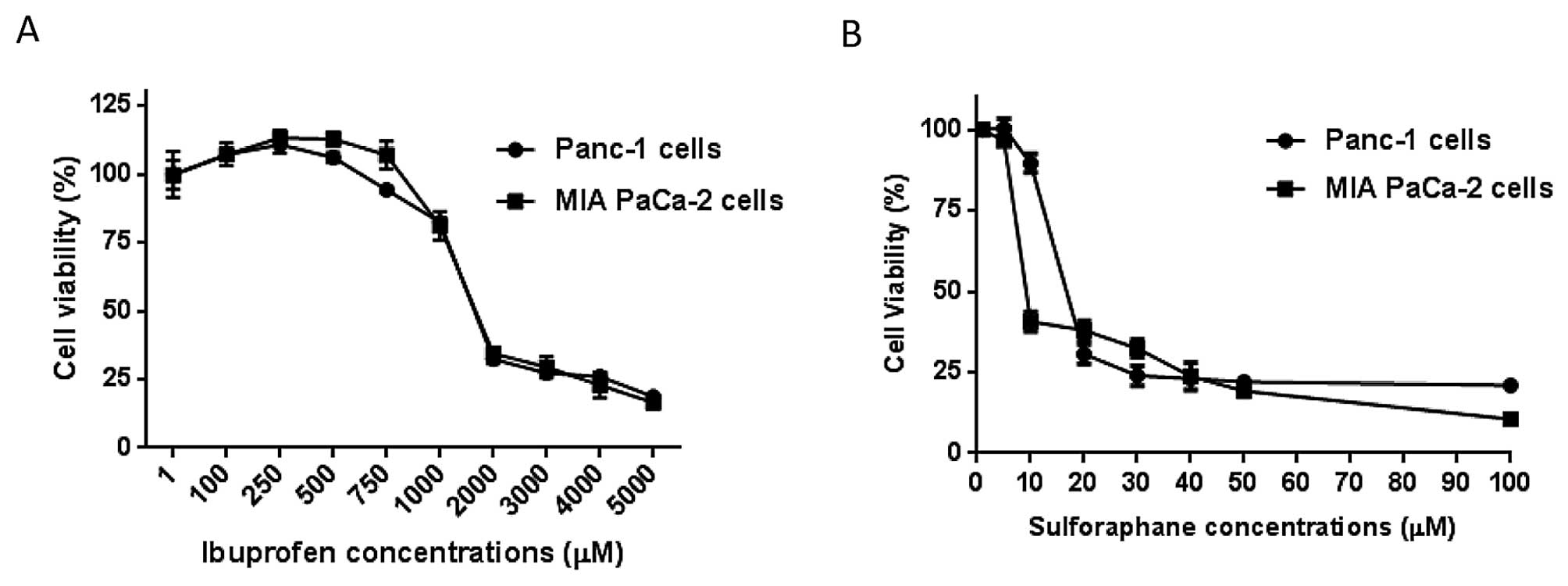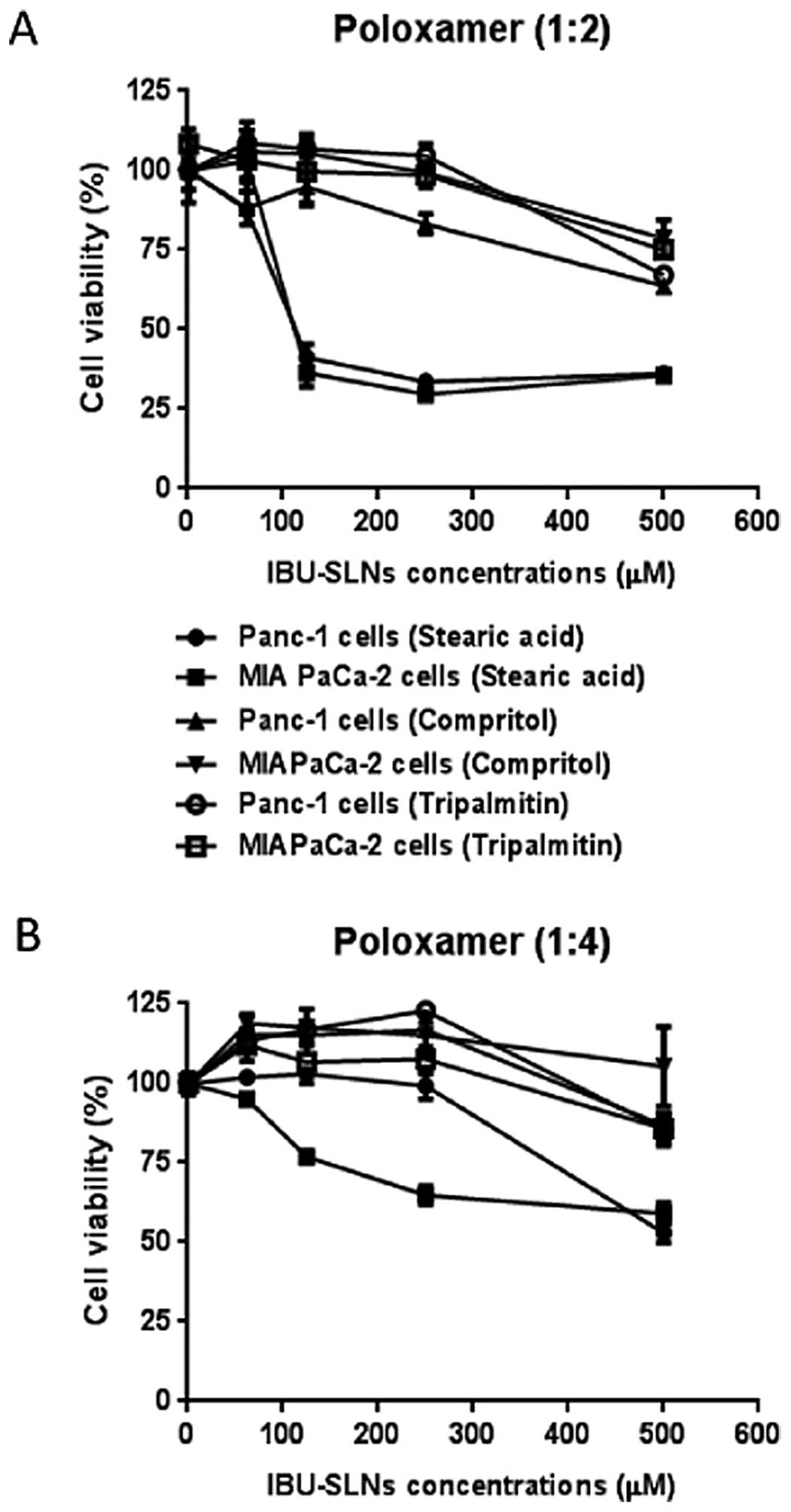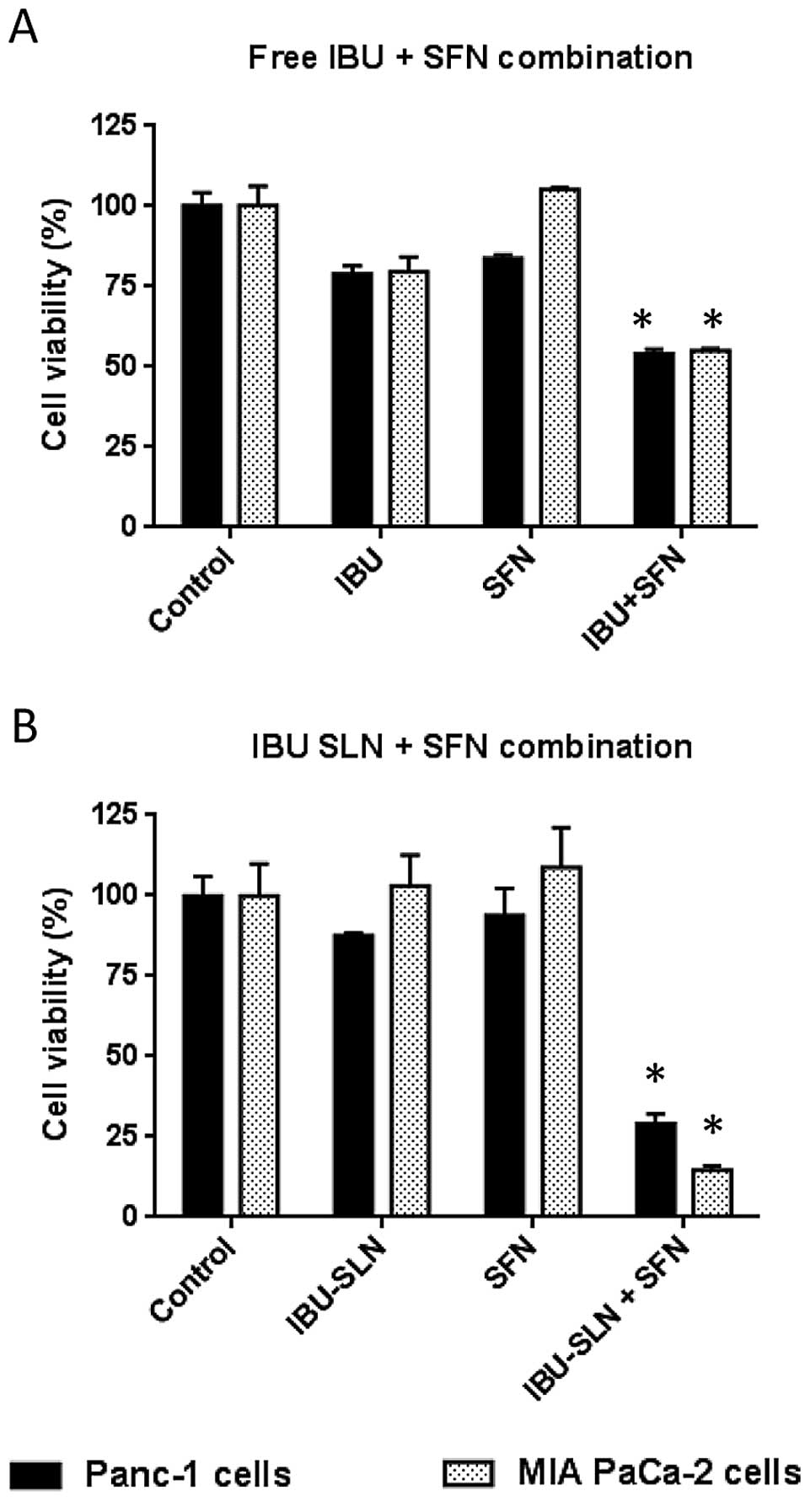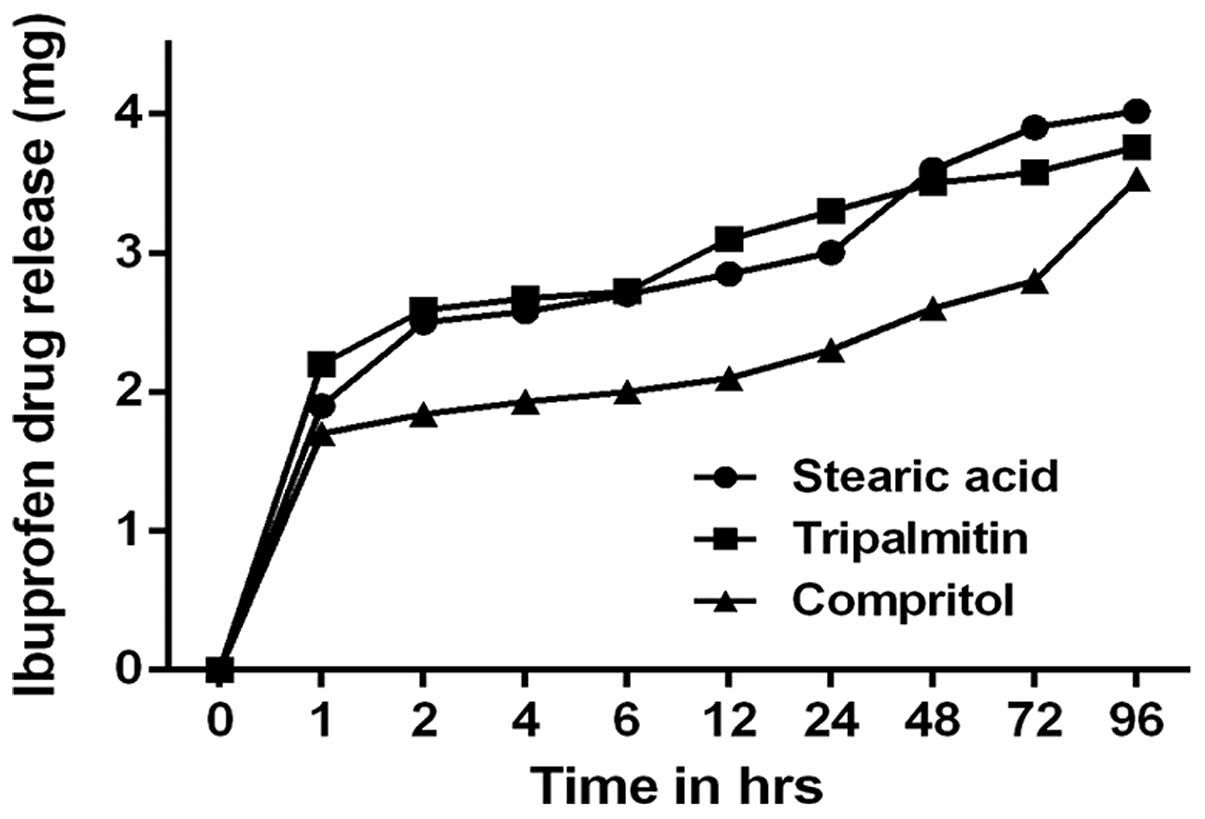|
1
|
Siegel R, Ma J, Zou Z and Jemal A: Cancer
statistics, 2014. CA Cancer J Clin. 64:9–29. 2014. View Article : Google Scholar : PubMed/NCBI
|
|
2
|
Grandhi BK, Thakkar A, Wang J and Prabhu
S: A novel combinatorial nanotechnology-based oral chemopreventive
regimen demonstrates significant suppression of pancreatic cancer
neoplastic lesions. Cancer Prev Res. 6:1015–1025. 2013. View Article : Google Scholar
|
|
3
|
Chaudhary A, Sutaria D, Huang Y, Wang J
and Prabhu S: Chemoprevention of colon cancer in a rat
carcinogenesis model using a novel nanotechnology-based combined
treatment system. Cancer Prev Res. 4:1655–1664. 2011. View Article : Google Scholar
|
|
4
|
Thakkar A, Sutaria D, Grandhi BK, Wang J
and Prabhu S: The molecular mechanism of action of aspirin,
curcumin and sulforaphane combinations in the chemoprevention of
pancreatic cancer. Oncol Rep. 29:1671–1677. 2013.PubMed/NCBI
|
|
5
|
Sutaria D, Grandhi BK, Thakkar A, Wang J
and Prabhu S: Chemoprevention of pancreatic cancer using
solid-lipid nanoparticulate delivery of a novel aspirin, curcumin
and sulforaphane drug combination regimen. Int J Oncol.
41:2260–2268. 2012.PubMed/NCBI
|
|
6
|
Palayoor ST, Bump EA, Calderwood SK,
Bartol S and Coleman CN: Combined antitumor effect of radiation and
ibuprofen in human prostate carcinoma cells. Clin Cancer Res.
4:763–771. 1998.PubMed/NCBI
|
|
7
|
Yao M, Zhou W, Sangha S, et al: Effects of
nonselective cyclooxygenase inhibition with low-dose ibuprofen on
tumor growth, angiogenesis, metastasis, and survival in a mouse
model of colorectal cancer. Clin Cancer Res. 11:1618–1628. 2005.
View Article : Google Scholar : PubMed/NCBI
|
|
8
|
Bonelli P, Tuccillo FM, Federico A, et al:
Ibuprofen delivered by poly(lactic-co-glycolic acid) (PLGA)
nanoparticles to human gastric cancer cells exerts
antiproliferative activity at very low concentrations. Int J
Nanomed. 7:5683–5691. 2012. View Article : Google Scholar
|
|
9
|
Lanas A: A review of the gastrointestinal
safety data - a gastroenterologist’s perspective. Rheumatology.
49(Suppl 2): ii3–ii10. 2010. View Article : Google Scholar
|
|
10
|
Mallen SR, Essex MN and Zhang R:
Gastrointestinal tolerability of NSAIDs in elderly patients: a
pooled analysis of 21 randomized clinical trials with celecoxib and
nonselective NSAIDs. Curr Med Res Opin. 27:1359–1366. 2011.
View Article : Google Scholar : PubMed/NCBI
|
|
11
|
Brigger I, Dubernet C and Couvreur P:
Nanoparticles in cancer therapy and diagnosis. Adv Drug Deliv Rev.
54:631–651. 2002. View Article : Google Scholar : PubMed/NCBI
|
|
12
|
Potta SG, Minemi S, Nukala RK, et al:
Preparation and characterization of ibuprofen solid lipid
nanoparticles with enhanced solubility. J Microencapsul. 28:74–81.
2011. View Article : Google Scholar
|
|
13
|
Kokawa A, Kondo H, Gotoda T, et al:
Increased expression of cyclooxygenase-2 in human pancreatic
neoplasms and potential for chemoprevention by cyclooxygenase
inhibitors. Cancer. 91:333–338. 2001. View Article : Google Scholar : PubMed/NCBI
|
|
14
|
O’Driscoll CM: Lipid-based formulations
for intestinal lymphatic delivery. Eur J Pharm Sci. 15:405–415.
2002. View Article : Google Scholar
|
|
15
|
Mehnert W and Mäder K: Solid lipid
nanoparticles: production, characterization and applications. Adv
Drug Deliv Rev. 47:165–196. 2001. View Article : Google Scholar : PubMed/NCBI
|
|
16
|
Matusheski NV, Juvik JA and Jeffery EH:
Heating decreases epithiospecifier protein activity and increases
sulforaphane formation in broccoli. Phytochemistry. 65:1273–1281.
2004. View Article : Google Scholar : PubMed/NCBI
|
|
17
|
Fahey JW, Haristoy X, Dolan PM, et al:
Sulforaphane inhibits extracellular, intracellular, and
antibiotic-resistant strains of Helicobacter pylori and prevents
benzo[a]pyrene-induced stomach tumors. Proc Natl Acad Sci USA.
99:7610–7615. 2002. View Article : Google Scholar
|
|
18
|
Kuroiwa Y, Nishikawa A, Kitamura Y, et al:
Protective effects of benzyl isothiocyanate and sulforaphane but
not resveratrol against initiation of pancreatic carcinogenesis in
hamsters. Cancer Lett. 241:275–280. 2006. View Article : Google Scholar : PubMed/NCBI
|
|
19
|
Chung FL, Conaway CC, Rao CV and Reddy BS:
Chemoprevention of colonic aberrant crypt foci in Fischer rats by
sulforaphane and phenethyl isothiocyanate. Carcinogenesis.
21:2287–2291. 2000. View Article : Google Scholar
|
|
20
|
Kallifatidis G, Rausch V, Baumann B, et
al: Sulforaphane targets pancreatic tumour-initiating cells by
NF-kappaB-induced anti-apoptotic signalling. Gut. 58:949–963. 2009.
View Article : Google Scholar
|
|
21
|
Sze A, Erickson D, Ren L and Li D:
Zeta-potential measurement using the Smoluchowski equation and the
slope of the current-time relationship in electroosmotic flow. J
Colloid Interface Sci. 261:402–410. 2003. View Article : Google Scholar
|
|
22
|
Petersen S, Steiniger F, Fischer D, Fahr A
and Bunjes H: The physical state of lipid nanoparticles influences
their effect on in vitro cell viability. Eur J Pharm Biopharm.
79:150–161. 2011. View Article : Google Scholar : PubMed/NCBI
|
|
23
|
Schöler N, Hahn H, Müller RH and
Liesenfeld O: Effect of lipid matrix and size of solid lipid
nanoparticles (SLN) on the viability and cytokine production of
macrophages. Int J Pharm. 231:167–176. 2002. View Article : Google Scholar : PubMed/NCBI
|
|
24
|
Schöler N, Olbrich C, Tabatt K, Müller RH,
Hahn H and Liesenfeld O: Surfactant, but not the size of solid
lipid nanoparticles (SLN) influences viability and cytokine
production of macrophages. Int J Pharm. 221:57–67. 2001. View Article : Google Scholar : PubMed/NCBI
|
|
25
|
Arnarson T and Elworthy PH: Effects of
structural variations on non-ionic surfactants on micellar
properties and solubilization: surfactants containing very long
hydrocarbon chains. J Pharm Pharmacol. 33:141–144. 1981. View Article : Google Scholar : PubMed/NCBI
|
|
26
|
Sanna V, Caria G and Mariani A: Effect of
lipid nanoparticles containing fatty alcohols having different
chain length on the ex vivo skin permeability of Econazole nitrate.
Powder Technol. 201:32–36. 2010. View Article : Google Scholar
|
|
27
|
Patil S, Sandberg A, Heckert E, Self W and
Seal S: Protein adsorption and cellular uptake of cerium oxide
nanoparticles as a function of zeta potential. Biomaterials.
28:4600–4607. 2007. View Article : Google Scholar : PubMed/NCBI
|
|
28
|
Bernfield M, Götte M, Park PW, et al:
Functions of cell surface heparan sulfate proteoglycans. Annu Rev
Biochem. 68:729–777. 1999. View Article : Google Scholar
|
|
29
|
Win KY and Feng SS: Effects of particle
size and surface coating on cellular uptake of polymeric
nanoparticles for oral delivery of anticancer drugs. Biomaterials.
26:2713–2722. 2005. View Article : Google Scholar
|
|
30
|
Cheng H, Zhu JL, Zeng X, Jing Y, Zhang XZ
and Zhuo RX: Targeted gene delivery mediated by
folate-polyethylenimine-block-poly(ethylene glycol) with receptor
selectivity. Bioconjug Chem. 20:481–487. 2009. View Article : Google Scholar : PubMed/NCBI
|
|
31
|
Al-Wadei HA, Al-Wadei MH, Ullah MF and
Schuller HM: Celecoxib and GABA cooperatively prevent the
progression of pancreatic cancer in vitro and in xenograft models
of stress-free and stress-exposed mice. PLoS One. 7:e433762012.
View Article : Google Scholar : PubMed/NCBI
|
|
32
|
Mukherjee P, Basu GD, Tinder TL, et al:
Progression of pancreatic adenocarcinoma is significantly impeded
with a combination of vaccine and COX-2 inhibition. J Immunol.
182:216–224. 2009. View Article : Google Scholar
|
|
33
|
Streicher SA, Yu H, Lu L, Kidd MS and
Risch HA: Case-control study of aspirin use and risk of pancreatic
cancer. Cancer Epidemiol Biomarkers Prev. 23:1254–1263. 2014.
View Article : Google Scholar : PubMed/NCBI
|














